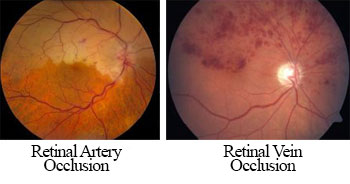What Is Retinal Artery and Vein Occlusion?
Retinal Artery Occlusion, also known as Central Retinal Vein Occlusion, Branch Retinal Artery Occlusion, or Central Retinal Artery Occlusion, refers to a blockage in the small arteries or the veins that carry the blood to the retina.
What Causes Retinal Artery and Vein Occlusion?
The retinal arteries and veins can become blocked by a blood clot (ischemia) that then gets stuck in the arteries. This is more likely to happen when someone has atherosclerosis, otherwise known as hardening of the arteries. Clots can also travel to other areas in the body and block an artery in the retina. The most common places for these clots are in the heart and also the carotid artery, located in the neck.
Risk factors for retinal artery and vein occlusion include the following:
- Unhealthy diet
- Carotid Artery Disease, where two large blood vessels in the neck become narrowed or even blocked due to chronic inflammation
- Diabetes
- Heart valve problems
- Heart rhythm problems (atrial fibrillation)
- High blood pressure
- High levels of fat in the blood (hyperlipidemia)
- Intravenous drug abuse
- Temporal arteritis
If the retinal artery or the vein becomes blocked, a part of the retina doesn’t get enough blood and oxygen, the result of which can cause partial vision loss.
The symptoms of Retinal Artery and Vein Occlusion can include a sudden blurring or even loss of vision in one eye, or part of the eye. This can be temporary, i.e. just few seconds or minutes, or it could be semi-permanent. If a blood clot develops in the eye, then it could be an indicator of a blood clot elsewhere that may result in a stroke.
If you are unsure of the cause and do not have access to a medical opinion, then act quickly—stop eating all unhealthy foods, drink 6-8 glasses of water with a pinch of bicarb in each glass, and only eat leafy greens and salad for all meals until you are stable.
Refer to our action plan for help with this.

